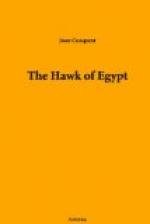There is no describing the smell of the East.
The sale of really good animals—the other kind you can buy by lifting a finger in the streets—takes place twice a month in a small square near the Suk-en Nahlesin; but as the way to it leads through many dirty and twisting lanes, few Europeans ever get so far.
The stock is tethered to iron rings in the ground, the vendors squat near by, but at a safe distance from teeth, claws or hoofs; the purchasers stand still farther off; there sometimes occurs a free fight, when the length of the chain that tethers the jaguar next the hunting cheetah is too long by a foot or so; and the noise is always deafening.
Abdul, falconer of Shammar—which district is to be found on the holy road to Mecca—being of that locality specialises in the shahin, which is a species of hawk; visits the market by appointment only, and, being independent and a specialist, does not always keep that appointment.
Damaris turned suddenly into the market and hurriedly looked round for shelter, which she found in an arched doorway leading to the usual court of the native house.
Zulannah the courtesan peered down upon her from between the silken curtains of her balcony, and clapped her hands twice so that her woman-slaves ran quickly to watch and whisper about this white woman who stood unattended in the open market. They giggled in the insufferable Eastern way, and pointed across the Square, where the whole of the male population surged about two men. But Zulannah, the recognised beauty of the North of Egypt, shrugged her dimpled shoulders as she stuffed over-large portions of sweetmeats between her dazzling teeth and stretched herself upon a divan to watch the scene over the way.
Abdul, falconer of Shammar, bearded and middle-aged, stood with a shahin of Jaraza upon his fist and a hooded eyess—which means a young hawk or nestling taken from the nest—of the same species upon a padded and spiked perch beside him, whilst hooded or with seeled eyes, upon perch or bough, were other yellow or dark-eyed birds of prey; short-winged hawks, a bearded vulture, a hobby, a passage Saker.
But it was not upon Abdul or his stock that the girl’s eyes rested, nor, peradventure, the eyes behind the silken curtains.
The central figure of the glowing picture was that of Hugh Carden Ali, the eldest and best-beloved son of Hahmed the Sheikh el-Umbar and Jill, his beautiful, English and one and only wife; the son conceived in a surpassing love and born upon the desert sands.
“An Englishman,” said Damaris softly as she withdrew yet further into the sheltering doorway and unleashed the dog; and still further back, when the man suddenly turned and looked across the Square as though in search of someone. “No! a native,” she added, as she noticed the crimson tarbusch. “And yet . . .”
She was by no means the first to wonder as to the nationality of the man.




